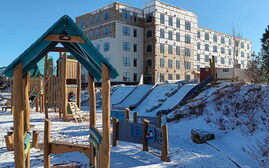The Maine Housing Crunch: Construction costs rise across the board
 Photo / Fred Field
Matt Masse, vice president of purchasing at Belgrade-based Hammond Lumber, says he’s never seen materials rise at the “velocity” seen currently.
Photo / Fred Field
Matt Masse, vice president of purchasing at Belgrade-based Hammond Lumber, says he’s never seen materials rise at the “velocity” seen currently.
The Szanton Co., a Portland-based developer, has a housing project in Bath that will take 19 months to construct, up from a planned timeline of 12 to 13 months.
The reason: lack of available labor.
“Costs are 30% over budget, so we have to find more sources of funding or find areas to cut,” says Amy Cullen, Szanton Co.’s vice president and project partner.
“The biggest issue in 2022 is the lack of workforce to build the housing. We need sheet-rockers, masons, carpenters. Construction costs are going through the roof. Material costs, the lack of availability of labor, all relates to the overall price tag,” Cullen says.
The complaints are the same, whether it’s affordable housing, workforce housing or luxury units: labor costs on projects have surged about 30% in the past year and material costs are up 25% to 30% for building necessities such as lumber, window, steel. Time delays also add to costs as the delivery of materials can now be an extra four to five months.
Roccy Risbara, president of Scarborough-based Risbara Bros. Construction, which is redeveloping the old Scarborough Downs, says a semi-custom home that used to take five months to complete is now a 10-month timeline. He blames the struggles in getting labor and materials.
Risbara says his 54-year-old construction firm has had to scramble to buy whatever materials it can get, whenever they can get them, rather than ordering materials on-demand for each project. That means warehousing supplies, which adds to the costs.
“Material prices are extremely high and that’s if you can even get them. It used to be cabinets, now it’s appliances. You can’t get a refrigerator in this country right now,” Risbara says.
“Never in my career have I seen such velocity of price increases and the market’s ability to absorb them,” says Matt Masse, vice president of purchasing at Hammond Lumber in Belgrade.
Lumber and plywood prices have been volatile, influenced by commodities trading, international tariffs and labor that’s been constrained by COVID protocols in Canadian and other producing nations. Doors, windows and flooring have extended lead times for delivery due, in part to labor to produce the products, shipping and freight delays and even a deep freeze in Texas led to a huge runup in specialized chemical costs.
“Availability is the problem. And that affects the price,” Masse says.
“If you’re missing one screw, you can’t ship the window. Without molding that might be made overseas, you can’t finish an interior. And then you can’t finish a house. You can’t make the cake without the egg,” Masse says.














0 Comments